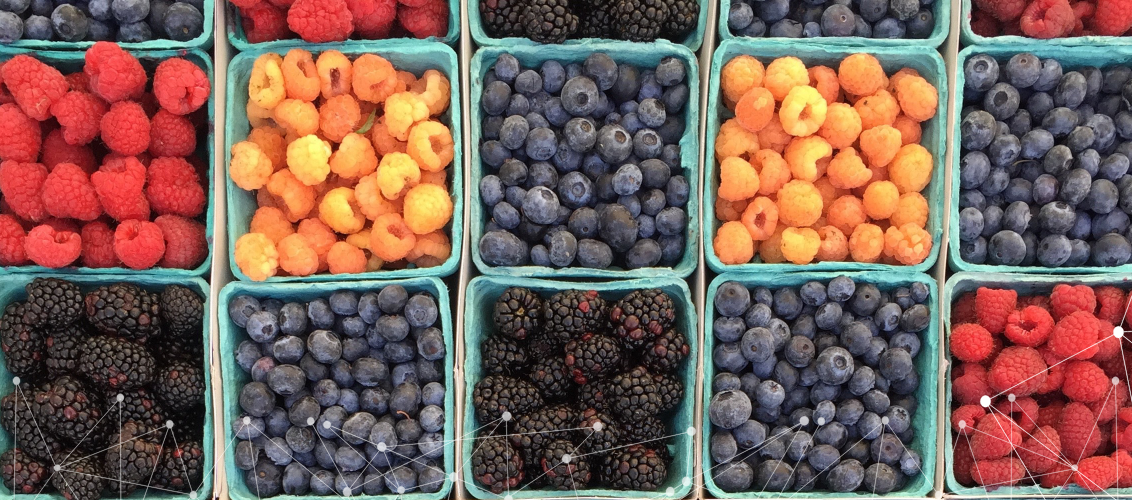
Functional Food: 25 berries you have to know about
Berries are known to have massive functionality and contain botanical ingredients that positively affect our bodies. Here is a summary of the commonly known, traditional, and researched benefits of berries for our bodies.
Hackberry (Celtis Occidentalis) – Native to North America and Canada, these berries have been used by Native Indians to treat jaundice and sore throats due to antioxidant properties.
Sugarberry (Celtis Laevigata) – also known as Texan Hackberry, is a southern state variety of hackberries with similar medicinal properties.
Bunchberry (Cornus Canadensis) – A native of Asia, North America, Canada, and Greenland, is found in plants related to the creeping dogwood genus. This berry is a strong antibiotic, antiseptic, and anti-inflammatory. Teas derived from leaves can be used to treat fever, cough, and lung disease.
Barbados Cherry / Acerola (Malpighia emarginata) – this berry is native to the Caribbean and parts of Central America. Richer than most other fruit in vitamin C, acerola is used in the agricultural processing of vitamins and helps absorb dietary iron. In addition to relief from respiratory problems, this berry has other therapeutic properties due to antioxidants, cyanidins, and quercetin, which also may reduce the effects of diabetes.
Siberian ginseng Berry (Eleutherococcus senticosus) Native to Northeast Asia, also known as the Devil’s bush. Berries have historically been used to treat colds and improve the immune system, especially inflammatory disorders such as rheumatoid arthritis. Dry fruits, eaten as milk, are high in calcium and minerals and flavonoids.
Cranberry (Vaccinium macrocarpon) – A native of North America, cranberry is a common and nutritious berry grown on vines, some of which are more than 150 years old in Massachusetts. Packed full of Vitamin C, the sailors used it to guard against scurvy. These are rich in anthocyanins, mainly cyanidin & peonidin and flavonol, myricetin & kaempferol. These also contribute to its disease-fighting capacity as a cardiovascular agent and protect the digestive and urinary tract.
Aronia (Rosacae sp.) – A shrub originating in North America, but is now cultivated in Eastern Europe because of its ability to ‘flush’ the saliva from the lips. Aronia is also known as the chokeberry. It protects and improves the immune system and provides a rich health supply for vitamins, manganese, and vitamin C.
Snowberry (Symphoricarpos albus)-also known as waxberry or ghostberry; they are native to North and Central America. Berries contain saponins, and they are very inedible and can be poisonous in large amounts. Nevertheless, Native Americans used berries to heal cuts and eye infections.
Bearberry (indigenous kinnickinnick) – A healthy source of protein for Polar Bears in the Arctic. These berries are harvested for their medicinal properties and used in herbal remedies for pain relief treatment of arthritis and gout. But feed with caution as overconsumption can lead to harmful side effects.
Acai (Arecaceae) – Superfood, as fatty acids, proteins, and anthocyanins that strengthen the immune system are abundant in them. They are a dark purple fruit from South American palm trees and dried in many supermarkets.
Mulberry (Morus sp.) – Mulberries, black/white/red are sweet, nutritious berries rich in antioxidant anthocyanins and packed with vitamins C, K1 & E, Iron, and potassium, which improve immunity.
Salmonberry (Rubus spectabilis) – A native of the Pacific Northwest, Western Central, and Northwest Europe. Salmonberry is closely related to strawberry, thimbleberry, and cloudberry. Rich in manganese, vitamins A, C, and K, berries have cardiovascular defense properties.
Schisandra berry (Schisandra chinensis) – Fruit is also known as Magnolia berry or Five Flavor Fruit and is native to Northern China and Russia’s forests. Berry seeds contain dibenzo-cyclooctadiene lignans that show hepatoprotective effects with the potential to increase the amount of vitamin C in the liver. Berries are rich in antioxidants that protect the skin, heart, and liver and benefit from the treatment of respiratory diseases.
Huckleberry (Vaccinium ovatum) – Native to the Pacific Northwest, elevated vitamin C levels are believed to protect against heart disease and eye diseases.
Agarita (Mahonia Trifoliolata) – A wild currant from Texas. The plant roots have been used by indigenous Americans to deal with antiseptic fever, wounds, and diseases of the stomach.
Indian Amalaki Gooseberry – Amalaki -Indian Gooseberry – These are small fibrous trees bearing fruit with a sour taste, cultivated mainly for their Ayurvedic properties, and used historically to treat colds among other diseases. Amalaki is the name given to Amalaki. The berries have good antioxidants, anti-inflammatory properties and are high in vitamin C, phenols, alkaloids, and tannins.
Nanny Berry (Viburnum Lentago) – A native of North America, also known as sheep berry, the fruit can be used to treat respiratory ailments and stomach disorders and anxiety and pain relief.
Gooseberry (Ribes sp.) – A native of Europe, Caucasus, and Northern Africa, gooseberries are closely related to currants and are widely used to reduce cholesterol rates and relieve chronic heartburn. Rich in vitamins C, B5 & B6, magnesium, manganese, and potassium, they quickly improve the immune system.
Himalayan Blackberry (Rubus armeniacus)-This berry is initially native to Armenia and Northern Iran and has become widely naturalized elsewhere. It is considered an invasive plant that colonizes roadsides and pastures. It has close medicinal applications to the most common blackberry, Rubus Fructicosus.
Juneberry (Amelanchier canadensis) – Also known as Canadian Serviceberry, is found in hedgerows in North America and Britain. Packed with vitamins and minerals, it can be turned into a medicinal tea to improve the immune system.
Farkleberry (vaccinium arboreum) – Also known as Sparkleberries, they are astringent and taste-sharp but have been used as a herbal cure for diarrhea and dysentery. They do have antiseptic properties and can treat sore throats and conjunctivitis.
Barberry (Berberis Vulgaris) – Native to Europe, Africa, and Asia, these sour berries can be consumed when cooked – rich in vitamin C, containing an alkaloid antioxidant, berberine, commonly used for stomach diseases and skin infections.
Blackberry (Rubus fructicosus) – Packed with tannins, gallic acid, villosin, and magnesium, blackberries have significant antimicrobial, anticancer, and anti-diabetic effects.
Elderberry (Sambucus nigra)- This is one of the most widely used medicinal berries in the world, used in ancient times, from native Americans to ancient Egyptians to cure colds and flu symptoms. Caution must be added, however, as raw berries must be cooked before they are consumed.
Goji Berry (Lycium barnarum / Lycium chinense) – Also known as wolfberries, they are endemic to Asia. Berries are rich in antioxidants, particularly zeaxanthin, which protects the eyes from UV light. Boosted by vitamins A & C, they are similar in their antioxidant effect on blueberries and are used to boost immunity from colds, heart disease, and even diabetes.
